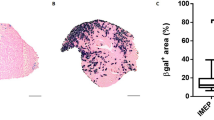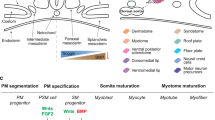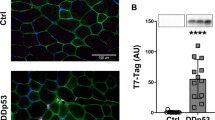Abstract
The goal of this study was to determine whether insulin-like growth factor-I (IGF-I) gene delivery by electroporation promotes repair after muscle injury. An injury–repair model was created using mice in which a hamstring muscle was cut and sutured. A total of 50 μg of IGF-I DNA or green fluorescent protein (GFP) DNA (both in pCAGGS) was injected into the lesion and introduced into muscle cells by electrostimulation using an electric pulse generator. The number of regenerating muscle fibers in the IGF-I DNA group was significantly more than that in the GFP DNA group at 2 weeks after injection. The diameter of regenerating muscle fibers from the IGF-I DNA group was larger than that of the GFP DNA group at 4 weeks after injection. There was no significant difference in the serum IGF-I concentration between the IGF-I DNA group and the GFP DNA group at 1, 2, and 4 weeks after injection. However, muscle IGF-I concentration in the IGF-I DNA injection group was significantly greater than that in the GFP DNA injection group at 2 weeks after injection. These results demonstrated that the effects of enhanced IGF-I production were local and limited to the injected area. The ratio (injected/uninjected; intact) of the amplitude of compound muscle action potentials (CMAP) in the IGF-I DNA injection group was greater than that in the GFP DNA injection group at 4 weeks after injection and of the control group. In conclusion, IGF-I gene transfer by electroporation proved to be a simple, safe, inexpensive, and effective method to promote the regeneration of injured muscles in our injury model.
This is a preview of subscription content, access via your institution
Access options
Subscribe to this journal
Receive 12 print issues and online access
$259.00 per year
only $21.58 per issue
Buy this article
- Purchase on Springer Link
- Instant access to full article PDF
Prices may be subject to local taxes which are calculated during checkout







Similar content being viewed by others
References
Wolff JA et al. Direct gene transfer into mouse muscle in vivo. Science 1990; 247: 1465–1468.
Potter H . Electroporation in biology: methods, applications, and instrumentation. Anal Biochem 1988; 174: 361–373.
Titomirov AV, Sukharev S, Kistanova E . In vivo electroporation and stable transformation of skin cells of newborn mice by plasmid DNA. Biochem Biophys Acta 1991; 1088: 131–134.
Aihara H, Miyazaki J . Gene transfer into muscle by electroporation in vivo. Nat Biotechnol 1998; 16: 867–870.
Kasemkijwattana C et al. Use of growth factors to improve muscle healing after strain injury. Clin Orthop 2000; 370: 272–285.
Menetrey J et al. Growth factors improve muscle healing in vivo. J Bone Joint Surg 2000; 82B: 131–137.
Engert JC, Berglund EB, Rosenthal N . Proliferation precedes differentiation in IGF-I-stimulated myogenesis. J Cell Biol 1996; 135: 431–440.
Toneguzzo F, Keating A . Stable expression of selectable genes introduced into human hematopoietic stem cells by electric field-mediated DNA transfer. Proc Natl Acad Sci USA 1986; 83: 3496–3499.
Maruyama H et al. Skin-targeted gene transfer using in vivo electroporation. Gene Ther 2001; 8: 1808–1812.
Rizzuto G et al. Efficient and regulated erythropoietin production by naked DNA injection and muscle electroporation. Proc Natl Acad Sci USA 1999; 96: 6417–6422.
Hurme T, Kalimo H . Activation of myogenic precursor cells after muscle injury. Med Sci Sports Exerc 1992; 24: 197–205.
Allen RE, Boxhorn LK . Regulation of skeletal muscle satellite cell proliferation and differentiation by transforming growth factor-beta, insulin-like growth factor I, and fibroblast growth factor. J Cell Physiol 1989; 138: 311–315.
Goldspink DF et al. Muscle growth in response to mechanical stimuli. Am J Physiol 1995; 268: 288–297.
Powell-Braxton L et al. IGF-I is required for normal embryonic growth in mice. Genes Dev 1993; 7: 2609–2617.
Vergani L et al. Effects of low doses of glycosaminoglycans and insulin-like growth factor-I on motor neuron disease in wobbler mouse. Neurosci lett 1997; 228: 41–44.
Barton-Davis ER et al. Viral mediated expression of insulin-like growth factor I blocks the aging-related loss of skeletal muscle function. Proc Natl Acad Sci USA 1998; 95: 15603–15607.
Everett RS, Gerrard DE, Grant AL . Factors affecting production of luciferase and epitope-tagged IGF-I in porcine muscle after DNA injection. J Endocrinol 2000; 166: 255–263.
Barton-Davis ER, Shoturma DI, Sweeney HL . Contribution of satellite cells to IGF-I induced hypertrophy of skeletal muscle. Acta Physiol Scand 1999; 167: 301–305.
Draghia-Akli R et al. Myogenic expression of an injectable protease-resistant growth hormone-releasing hormone augments long-term growth in pigs. Nat Biotechnol 1999; 17: 1179–1183.
Huard J et al. Muscle injuries and repair: current trends in research. J Bone Joint Surg 2002; 84A: 822–831.
Menetrey J et al. Suturing versus immobilization of a muscle laceration. A morphological and functional study in a mouse model. Am J Sports Med 1999; 27: 222–229.
Kawakami N et al. Green fluorescent protein-transgenic mice: immune functions and their application to studies of lymphocyte development. Immunol Lett 1999; 70: 165–171.
Jeschke MG et al. IGF-1 gene transfer in thermally injured rats. Gene Ther 1999; 6:1015–1020.
Alila H et al. Expression of biologically active human insulin-like growth factor-I following intramuscular injection of a formulated plasmid in rats. Hum Gene Ther 1997; 8: 1785–1795.
Anwer K et al. Systemic effect of human growth hormone after intramuscular injection of a single dose of a muscle-specific gene medicine. Hum Gene Ther 1998; 9: 659–670.
Mathiesen I . Electropermeabilization of skeletal muscle enhances gene transfer in vivo. Gene Ther 1999; 6: 508–514.
Jones JI, Clemmons DR . Insulin-like growth factors and their binding proteins: biological actions. Endocr Rev 1995; 16: 3–34.
Lee CW et al. Biological intervention based on cell and gene therapy to improve muscle healing after laceration. J Musculoskeletal Res 2000; 4: 265–277.
Acsadi G et al. Dystrophin expression in muscles of mdx mice after adenovirus-mediated in vivo gene transfer. Hum Gene Ther 1996; 7: 129–140.
Caroni P, Grandes P . Nerve sprouting in innervated adult skeletal muscle induced by exposure to elevated levels of insulin-like growth factors. J Cell Biol 1990; 110: 1307–1317.
Shiotani A et al. Reinnervation of motor endplates and increased muscle fiber size after human insulin-like growth factor I gene transfer into the paralyzed larynx. Hum Gene Ther 1998; 9: 2039–2047.
Dubowitz V, Brook MH . Muscle Biopsy: A Modern Approac. WB. Saunders: London, 1973, pp 74–102.
Acknowledgements
We thank Dr Peter S Rotwein for providing us with rat IGF-I cDNA, and Dr Shiraishi and Ms Miyazaki for their technical assistance.
Author information
Authors and Affiliations
Rights and permissions
About this article
Cite this article
Takahashi, T., Ishida, K., Itoh, K. et al. IGF-I gene transfer by electroporation promotes regeneration in a muscle injury model. Gene Ther 10, 612–620 (2003). https://doi.org/10.1038/sj.gt.3301900
Received:
Accepted:
Published:
Issue Date:
DOI: https://doi.org/10.1038/sj.gt.3301900
Keywords
This article is cited by
-
Impact of intramuscular administration of lipid-soluble and water-soluble vehicles into regenerating muscle at the distinct phases of skeletal muscle regeneration
The Journal of Physiological Sciences (2018)
-
Bioinductive Scaffolds—Powerhouses of Skeletal Muscle Tissue Engineering
Current Pathobiology Reports (2017)
-
Potential Use of Gene Transfer in Athletic Performance Enhancement
Molecular Therapy (2007)
-
Comparative evaluation of IGF-I gene transfer and IGF-I protein administration for enhancing skeletal muscle regeneration after injury
Gene Therapy (2006)
-
Administration of insulin?like growth factor?1 (IGF?1) improves both structure and function of delta?sarcoglycan deficient cardiac muscle in the hamster
Basic Research in Cardiology (2005)



